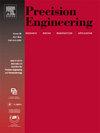Experimental and simulation analysis of surface morphology characteristics through multiple methods of ultrasonic vibration-assisted grinding using a single grain
IF 3.5
2区 工程技术
Q2 ENGINEERING, MANUFACTURING
Precision Engineering-Journal of the International Societies for Precision Engineering and Nanotechnology
Pub Date : 2025-01-28
DOI:10.1016/j.precisioneng.2025.01.023
引用次数: 0
Abstract
The high hardness and brittleness of silicon carbide (SiC) ceramics lead to issues such as low efficiency and severe surface damage during the machining process. Ultrasonic vibration-assisted grinding (UVAG) is an important means to efficiently machining this kind of material, but the surface quality obtained by different vibration modes varies. In order to investigate the scratch morphology characteristics and formation mechanisms by one-dimensional, two-dimensional and three-dimensional UVAG, this article conducted simulation and experimental studies on conventional grinding (CG), axial ultrasonic vibration-assisted grinding (AUVAG), elliptic ultrasonic vibration-assisted grinding (EUVAG) and composite ultrasonic vibration-assisted grinding (CUVAG) of SiC ceramics. The scratch morphology characteristics, the scratch width ratio, the grinding forces and the distribution of residual stress in the four grinding modes were analyzed using a single grain. The results show that the fractures are more pronounced on the scratch sides created by CG and AUVAG, with poor morphology at the scratch bottom. But good morphologies at the scratch bottom in forms of small facets are acquired by EUVAG and CUVAG. The scratch width ratio increases in sequence of CG, AUVAG, EUVAFG and CUVAG, indicating that UAVG can effectively improve the material removal efficiency. Compared to CG, UVAG has a maximum reduction of 67.5 % in grinding force. Meanwhile, as the axial amplitude increases, the grinding forces of AUVAG and CUVAG first decrease and then increase; as the elliptic amplitude increases, the grinding forces of EUVAG and CUVAG slowly increases. In addition, the maximum residual stress of CG, AUVAG, CUVAG and EUVAG is decreased in sequence. EUVAG and CUVAG show lower and more evenly distributed residual stresses at the bottom of the scratch, which indicates that elliptic ultrasonic vibration can significantly improve surface quality and reduce residual stress. EUVAG performs best in improving the surface finish, while CUVAG strikes a good balance between high efficiency and low damage.
单粒超声振动辅助磨削多种方法的表面形貌特征实验与仿真分析
碳化硅陶瓷的高硬度和高脆性导致其在加工过程中存在加工效率低、表面损伤严重等问题。超声振动辅助磨削(UVAG)是高效加工此类材料的重要手段,但不同的振动方式所获得的表面质量存在差异。为了研究一维、二维和三维超声振动辅助磨削的划痕形貌特征及其形成机理,本文对SiC陶瓷的常规磨削(CG)、轴向超声振动辅助磨削(AUVAG)、椭圆超声振动辅助磨削(EUVAG)和复合超声振动辅助磨削(CUVAG)进行了仿真和实验研究。以单晶粒为对象,分析了四种磨削方式的划痕形貌特征、划痕宽度比、磨削力和残余应力分布。结果表明,CG和AUVAG造成的划痕侧裂缝更为明显,划痕底部形貌较差;但是EUVAG和CUVAG在划痕底部以小切面的形式获得了良好的形貌。划痕宽度比从CG、AUVAG、EUVAFG到CUVAG依次增大,说明UAVG能有效提高材料去除效率。与CG相比,UVAG最大可减少67.5%的磨削力。同时,随着轴向振幅的增大,AUVAG和CUVAG的磨削力先减小后增大;随着椭圆幅值的增大,EUVAG和CUVAG的磨削力缓慢增大。另外,CG、AUVAG、CUVAG、EUVAG的最大残余应力依次减小。EUVAG和CUVAG在划痕底部的残余应力更低且分布更均匀,表明椭圆超声振动可以显著改善表面质量,降低残余应力。EUVAG在改善表面光洁度方面表现最好,而CUVAG在高效率和低损伤之间取得了很好的平衡。
本文章由计算机程序翻译,如有差异,请以英文原文为准。
求助全文
约1分钟内获得全文
求助全文
来源期刊
CiteScore
7.40
自引率
5.60%
发文量
177
审稿时长
46 days
期刊介绍:
Precision Engineering - Journal of the International Societies for Precision Engineering and Nanotechnology is devoted to the multidisciplinary study and practice of high accuracy engineering, metrology, and manufacturing. The journal takes an integrated approach to all subjects related to research, design, manufacture, performance validation, and application of high precision machines, instruments, and components, including fundamental and applied research and development in manufacturing processes, fabrication technology, and advanced measurement science. The scope includes precision-engineered systems and supporting metrology over the full range of length scales, from atom-based nanotechnology and advanced lithographic technology to large-scale systems, including optical and radio telescopes and macrometrology.

 求助内容:
求助内容: 应助结果提醒方式:
应助结果提醒方式:


